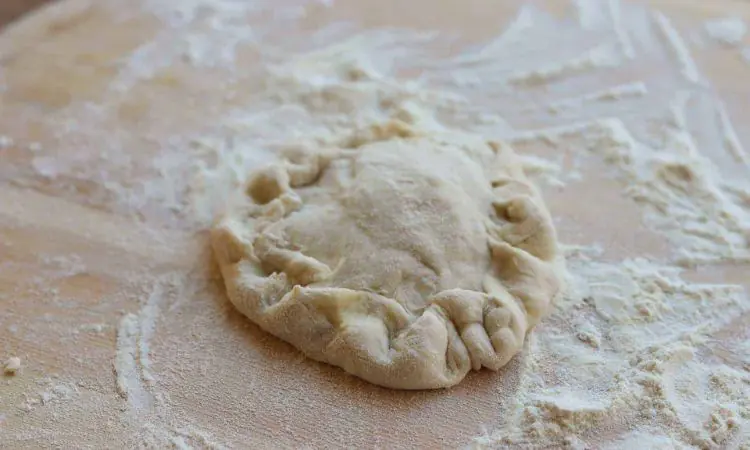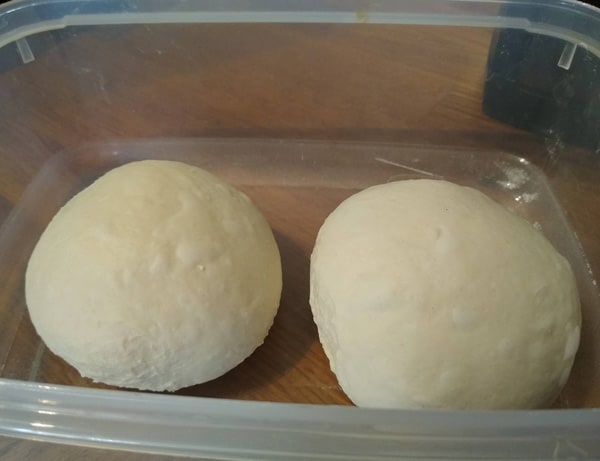To soften too-stiff pizza dough, knead in small amounts of water. Ensure the water is at a warm temperature to aid elasticity.
Perfecting pizza dough is an art, and crafting a pliable, stretchy mixture is crucial for that impeccable homemade pizza. A common challenge for pizza enthusiasts is stiff dough, which often results from too much flour or insufficient hydration. Aspiring chefs and pizza aficionados alike search frequently for solutions to this problem, making it a hot topic in the culinary world.
Knowing the right techniques to rectify stiff dough can transform your pizza-making experience. This intro serves as a guide to achieving the desired dough consistency, ensuring that your next homemade pizza is nothing short of perfection. Embrace these tips and watch your dough become as supple and workable as that of a seasoned pizzaiolo.
Assessing Stiff Pizza Dough
So, the pizza dough is too stiff. Don’t worry. This part of the journey will help find out why. Understanding the stiffness of pizza dough is key. It helps fix the dough and makes it perfect for baking. Let’s tackle the stiffness, one step at a time.
Identifying The Causes
- Too much flour: This is a common issue. Too much flour makes dough hard.
- Not enough water: Dough needs water to be soft. Not enough, and it’s stiff.
- Over-kneading: Kneading too much develops too much gluten. This makes dough tough.
- Low temperature: Cold environments stiffen the dough. Warmth is needed for a softer texture.
Impact On Pizza Quality
| Problem | Impact |
|---|---|
| Stiffness | Hard to shape and chew |
| Lack of Tenderness | The less enjoyable eating experience |
| Uneven Cooking | Possible burnt edges or undercooked middle |
Stiff dough may spoil the pizza’s quality. It leads to uneven cooking and hard crusts. Proper texture is vital for the perfect pizza experience. Identifying and fixing dough stiffness is crucial for a delicious outcome. Remember, the goal is a soft, pliable, and tasty crust that complements your toppings!

Warmth: The First Rescuer
If pizza dough feels like a rock, don’t panic. Warmth works wonders to soften the stiff dough. Imagine the dough waking up, getting flexible, and ready to roll. Let’s bring warmth in to save the day.
Cozy Counter-top Rest
Start by giving dough a warm spot to relax. Room temperature is key for the dough to become pliable. Place it on a counter and cover it with a clean cloth. The warmth from your kitchen will do the trick. Patience pays off as you wait for the dough to unwind.
Heating Pad Assistance
For faster results, use a heating pad. Set it to a low temperature. Wrap the dough in a damp cloth. Place it on the pad for a gentle heat treatment. Check the dough every few minutes. You want it soft, not cooked! Once it yields to a gentle poke, it’s ready to shape into a perfect pizza base.
- Use a warm, damp cloth to wrap the dough before placing it on the pad.
- Avoid high heat to prevent cooking the dough.
- Keep an eye on the dough to find the perfect softness.
Moisture Magic
When pizza dough turns out too stiff, don’t fret. With the Moisture Magic, a few simple tricks can transform that tough dough into a pliable masterpiece. Knowing how to adjust your dough’s consistency is crucial for perfect pizza. Let’s explore some moisture-driven solutions that will save your dough.
Gradual Water Integration
Gradual Water Integration
Adding water in small amounts is key.
- Start with a tablespoon of lukewarm water.
- Knead the dough gently after each addition.
- Watch the dough closely as it absorbs the moisture.
- Stop when the dough is soft but not sticky.
This technique improves dough elasticity. It also prevents overhydration. Always use a bowl or flat surface for kneading.
Oil: An Alternative Softener
Oil makes the dough softer and more manageable.
Choose the right type:
- Extra virgin olive oil for flavor.
- Canola oil for a neutral taste.
How to use oil:
| Step | Action |
|---|---|
| 1 | Add one teaspoon of oil. |
| 2 | Knead the dough until smooth. |
| 3 | Let it rest if necessary. |
These methods add flexibility and richness to the stiff dough.

Kneading: A Critical Step
Struggling with pizza dough that feels like a rock? Kneading is where the magic happens. It can transform stiff dough into a stretchy, pliable base ready for toppings. Let’s tackle this dough dilemma, ensuring your pizza crust is nothing short of perfection.
Proper Techniques
Correct kneading revives stiff dough. It’s all about stretching and folding. This process realigns the gluten, which is key. Here’s a simple guide to kneading dough like a pro:
- PRESS the dough with the heel of your hand.
- FOLD the dough over onto itself.
- TURN the dough a quarter rotation.
- Repeat for at least 5-10 minutes.
If the dough resists, let it rest. Short breaks relax the gluten. This makes kneading easier.
Tools To Aid Kneading
Tools can make kneading simple. They save time and effort. The right tools ensure consistency. Consider these:
| Tool | Use |
|---|---|
| Stand Mixer | Efficient for mixing and kneading with a dough hook. |
| Dough Scraper | Helps fold and divide dough without sticking. |
| Silicone Mat | Provides a non-stick surface for easy kneading. |
A damp cloth can also cover the dough during rest periods. This prevents drying out.
Warm water is a secret weapon. A few drops can soften the stiff dough. Add it gradually as you knead.
Remember, patience and proper technique turn tough dough into amazing pizza crusts!
Relaxing The Gluten
If your pizza dough feels like a rock, don’t panic! It’s all about giving gluten a little break. Gluten is the protein that gives dough its stretch and strength. Too much of it can mean tough dough. Let’s teach you how to coax that dough into a supple, workable state. Ready to turn that stiff dough into perfect pizza? Follow these simple steps to relax the gluten and create the perfect pizza base!
Understanding Rest Time
Think of rest time as a spa for your dough. During rest, gluten relaxes naturally, making the dough softer and more pliable.
- Short Rest: Even a quick 10-15 minute rest can make a difference.
- Long Rest: For best results, aim for 20-30 minutes if time permits.
While the dough rests, keep it covered to prevent drying. This leads us to our next point.
Cover And Let Dough Breathe
While your dough is resting, don’t let it dry out. Drying can create a crust on the dough and impede relaxation.
- Use plastic wrap directly on the dough surface for an airtight seal.
- Damp cloth: Alternatively, a warm, damp cloth atop the dough keeps it moist.
- Bowl method: Invert a bowl over the dough as a cover.
Ensuring that your pizza dough breathes without drying out is crucial for that perfect texture. After following these steps, you’re all set to shape and bake a delicious homemade pizza!
Solving Tough Dough Troubles
Ever faced a pizza dough that’s more rock than roll? You’re not alone. It happens to the best of chefs, and home cooks alike. Wrangling with a dough that’s turned tough can be both frustrating and disheartening. But fear not! With a few tweaks and a bit of patience, that sturdy dough can become the supple base for your dream pizza. Let’s knead our way through solving tough dough troubles.
Adjusting The Recipe
Before throwing in the towel, consider these adjustments:
- Add Water: Sometimes, all a stiff dough needs is a little more moisture. Begin by adding a teaspoon of warm water, knead thoroughly, and add more if necessary.
- Warmth Works: Warm conditions help gluten relax. Let your dough rest in a warm spot for 30 minutes.
- Oil for Suppleness: A drizzle of olive oil can make a stiff dough more pliable. Work the oil in with your hands.
Perform these adjustments in small increments. It’s easier to add more than to fix an overly wet or oily dough.
When To Start Over
Sometimes, a dough’s stubbornness signals a fresh start. Look for these signs:
| Sign | Action |
|---|---|
| Dough snaps back instantly | A little more kneading or resting might help |
| Unmixable dry flour remains | Add moisture or start anew if it’s substantial |
| Dough remains hard after adjustments | It’s time to begin again to ensure pizza success |
If starting over, ensure your measurements are precise. Mis-measured flour or water can make a dough too hard to handle.

Credit: mypizzacorner.com
Frequently Asked Questions On What To Do If Pizza Dough Is Too Stiff
Why Is My Pizza Dough Too Hard?
Over-kneading the dough or using too much flour can make pizza dough too stiff. This creates an overly dense structure due to the gluten networks becoming too tight.
How Can I Soften Stiff Pizza Dough?
Softening stiff pizza dough can be done by letting it rest. Cover it with a damp cloth and give it time to relax. This allows the gluten to loosen up, making it easier to shape.
What’s The Ideal Pizza Dough Texture?
The ideal pizza dough texture is soft and slightly tacky to the touch. It should stretch without tearing, indicating well-developed but not overworked gluten.
Can I Fix Overworked Pizza Dough?
Yes, overworked pizza dough can be fixed by covering it and letting it rest. The gluten strands will relax over time, alleviating some of the stiffness in the dough.
Conclusion
Tackling stiff pizza dough shouldn’t dampen your culinary adventures. By adding warmth and moisture, kneading thoroughly, or using patience with resting time, dough becomes pliable and ready to shape. Remember, practice perfects your pizza-making craft. For more tips and kitchen hacks, keep kneading through our content.
Keep baking, keep experimenting!

As the author of the “Ultimate Pizza Guide: Recipes, Tips & Secrets Revealed,” I’m dedicated to sharing my love for pizza and empowering others to create delicious homemade pizzas with ease. Join me on a journey to uncover the secrets to perfecting your pizza game!



